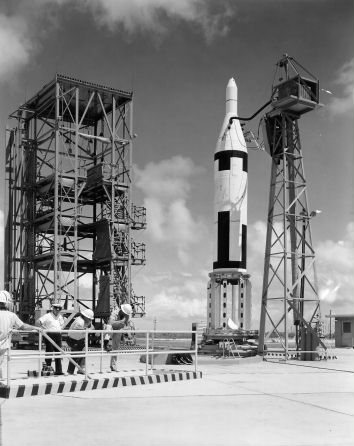POLARIS A1 FACT SHEET
By Cliff Lethbridge

Polaris A1 On Launch Pad, Photo Courtesy U.S. Navy
Classification: Fleet Ballistic Missile
Note: Fleet Ballistic Missiles are also referred to as Submarine-Launched Ballistic Missiles
Length: 28 feet
Diameter: 4 feet, 6 inches
Range: 1,380 miles
Date of First Cape Canaveral Launch: September 24, 1958
Date of Final Cape Canaveral Launch: September 4, 1963
Number of Cape Canaveral Launches: 109
Developed in the late 1950’s, the Polaris family provided the U.S. with its first submarine-based nuclear missiles. The first generation Polaris A1 became the ancestor of a missile family which comprises the backbone of current U.S. nuclear offensive capability. In 1955, the U.S. Navy was directed to participate in a joint venture with the Army Ballistic Missile Agency (ABMA) to create a sea-based version of the Jupiter IRBM. During the course of Jupiter testing, it became clear that the missile’s liquid fuels, especially volatile liquid oxygen, provided an unacceptable hazard during at-sea operations. It was also recognized that the Jupiter, or any similar liquid-fueled missile, was too difficult to maintain and operate either aboard ship or submarine. For these reasons, the U.S. Navy abandoned the Jupiter program in December, 1956. Instead, the option of deploying a solid-fueled missile was vigorously explored.
The need for a sea-based missile using solid fuel, lightweight construction, miniature inertial guidance, small nuclear devices and cold gas ejection from submarine tubes during uncertain environmental conditions provided considerable engineering challenges. With the highest military priority, Lockheed was assigned the task of developing this ambitious missile program. Lockheed selected Polyurethane Ammonium Perchlorate (PU/AP) solid fuel for the two-stage vehicle to eliminate the hazards associated with liquid fuel. In addition, a procedure for gas-propelled launching from submarine tubes was developed to eliminate the hazard of firing the missile’s first stage aboard ship. Test versions of the missile were first known as AX-6, then A1-X, but the name Polaris A1 was ultimately selected along with the military numerical designation of UGM-27A.
Aerojet-General first and second stage engines were encased in a steel frame. The first stage engine had four rotary exhaust nozzles, while the second stage engine had one. Each missile could carry a 500 kiloton nuclear warhead. The missile’s MIT/GE/Hughes inertial guidance system was linked to a GE fire control. A Westinghouse/MIT launch control system activated the high pressure gas flow which forced the missile out of its launch tube. The Polaris A1 was suitable for launching from ships as well as submarines and the U.S.S. Observation Island was outfitted for Polaris A1 launches with 2 missile tubes. The U.S. Navy also ordered a total of 41 Fleet Ballistic Missile (FBM) submarines, with five to be modified from existing submarines and 36 to be built from scratch.
The first five FBM submarines were ingeniously created by simply splitting existing submarines in two and inserting a 130-foot section amidship to house 16 missile tubes and support facilities. The first of these, named SSN 589 Scorpion, was renamed SSBN 598 George Washington following its completion to FBM status. Since it was the first FBM submarine completed, all five of these renovated submarines became known as the George Washington Class. SSBN 598 George Washington supported the first U.S. submarine-based missile launches. On July 20, 1960 a total of two Polaris A1 missiles were launched from the submarine as it sat submerged just off the coast of Cape Canaveral. Carrying 16 Polaris A1 missiles, SSBN 598 George Washington became the first operational FBM on November 15, 1960. But only the five George Washington Class submarines were actually deployed with Polaris A1 missiles. By this time, the upgraded Polaris A2 was already under development. As a result, the first five built-from-scratch FBM submarines, beginning with SSBN 608 Ethan Allen, and thus called the Ethan Allen Class, carried Polaris A1 missiles for test launches only. The Polaris A1 was officially retired from service on October 14, 1965 when the last George Washington Class submarine, SSBN 602 Abraham Lincoln, returned to port.


